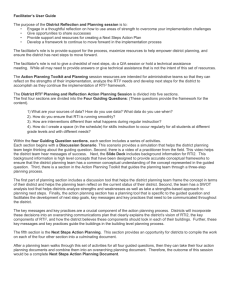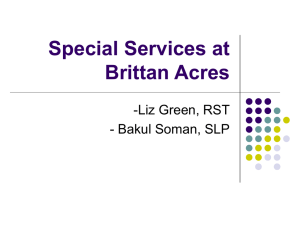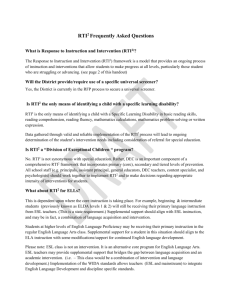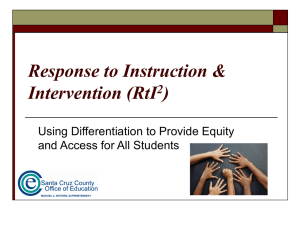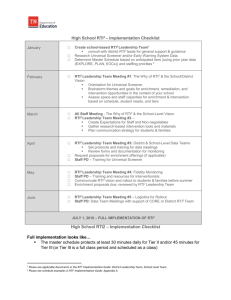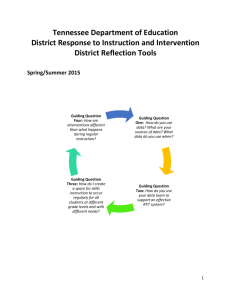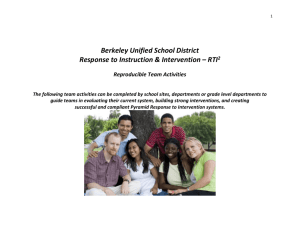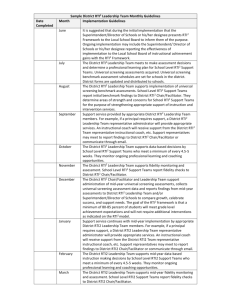RTI 2 Reflection Guide-Elementary
advertisement
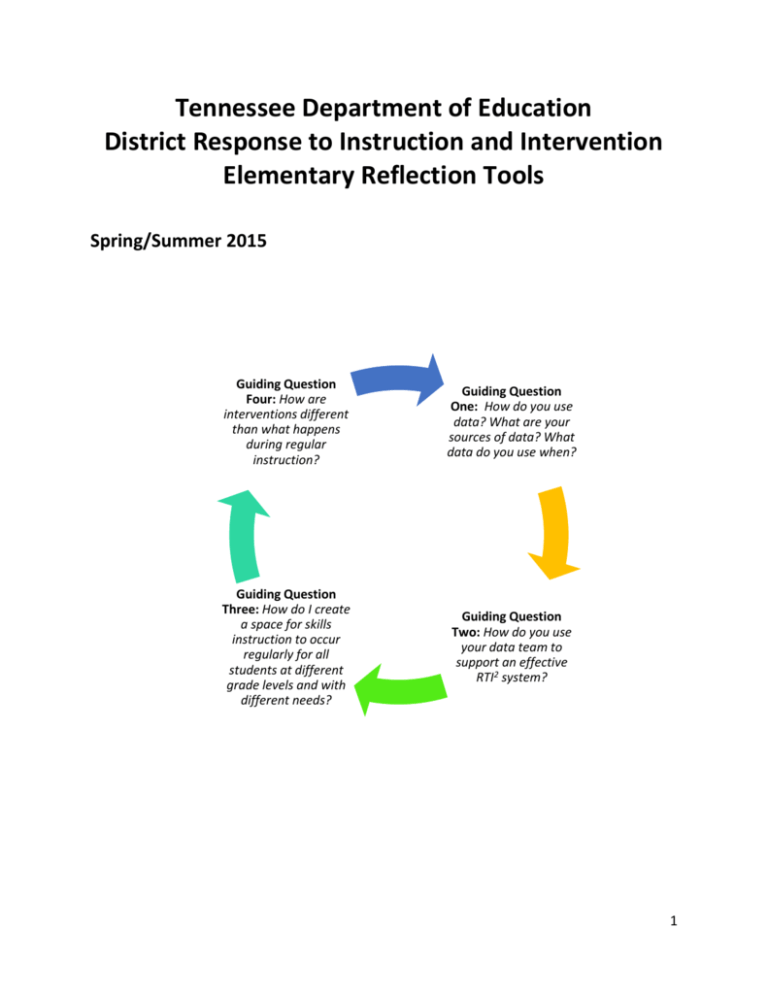
Tennessee Department of Education District Response to Instruction and Intervention Elementary Reflection Tools Spring/Summer 2015 Guiding Question Four: How are interventions different than what happens during regular instruction? Guiding Question One: How do you use data? What are your sources of data? What data do you use when? Guiding Question Three: How do I create a space for skills instruction to occur regularly for all students at different grade levels and with different needs? Guiding Question Two: How do you use your data team to support an effective RTI2 system? 1 Response to Instruction and Intervention is an ongoing process that requires continual reflection. It is essential that we share our successes and continue to overcome our problems of practice. The following Reflection Toolkit is a tool designed to support yearly reflection. This tool helps districts and schools identify areas of success and challenges that need to be areas of success. The Reason for RTI2 The role of the public education system is to prepare ALL students for success after high school. Response to Instruction and Intervention is designed to empower educators to give every student the opportunity to meet high expectations and the support to reach them. This three-tiered system helps educators differentiate instruction as students need extra help. Tennessee schools are moving to this framework over the next several years. Tennessee State Standards set high expectations for student achievement. The RTI² framework is a multi-tiered delivery system aligned with the department’s beliefs and allows for an integrated, seamless problem-solving model that addresses individual student needs. The RTI² framework relies on the premise of high-quality instruction and interventions tailored to student need where core instructional and intervention decisions are guided by student outcome data. The RTI² framework has district and school teams making local decisions to create an RTI2 framework. This framework allows school teams to identify the supports every child needs to achieve academically. The Road to RTI2 follows three principles 1. Leadership at the state, district, and building level is essential for ensuring the success of ALL students throughout the RTI2 Framework. 2. A culture of collaboration that is focused on student achievement, for both struggling and advancing students, should include educators, families and communities. 3. RTI2 is a process focused on prevention and early intervention that uses assessment data for instruction, intervention and transitions between tiers. This guide is designed to help you take a broad overarching review of your RTI2 experiences; then, select specific tools to analyze your next steps in your RTI2 process work for the following year. 2 Elementary Table of Contents Overall Year One Reflection This section is an overall reflection of your RTI2 processes for the year and is geared toward helping you find areas to focus on and dig deeper into the appropriate planning options below. 1. Narrative Tool Option p. 4 2. Likert Scale Option p. 5 Data Tool Focus Guiding Question One: How do you use data? What are your sources of data? What data do you use when? 1. Universal Screening Tool p. 7 2. Progress Monitoring Tool p. 8 RTI2 Data Team Support Guiding Question Two: How do you use your data team to support an effective RTI2 system? 1. School RTI2 Team Analysis p. 10 2. Elementary Fidelity Data Analysis p. 11 3. Communications and Developing Buy In Analysis p. 13 Scheduling Guiding Question Three: How do I create a space for skills instruction to occur regularly for all students at different grade levels and with different needs? 1. Schedule Analysis Tool p. 14 2. Staff Analysis Tool p. 15 Interventions Guiding Question Four: How are interventions different than what happens during regular instruction? Elementary Intervention Analysis Tool p. 16 3 The RTI2 Reflection Overview Survey is designed to help you reflect on where you are with implementation, where your data is improving, where your challenges are, and to help decide which additional tools will facilitate deeper analysis. Initial Reflection 1. What is our biggest success in utilizing the RTI2 framework to provide intervention for our students? 2. What skill areas did we see the largest success in this year? 3. What problems of practice did we overcome? 4. What gaps do we continue to see? 5. What is one area of the RTI2 framework that we continue to struggle to address? 4 Overview Survey When reflecting on the components of your buildings’ RTI2 framework. Answer the following statements. 5 Strongly Agree 4 Agree 3 Neutral 2 Disagree 1 Strongly Disagree 5 4 3 2 1 Data Tools and Data Support Systems School Culture My staff believes that the RTI2 framework will help all students become successful and access the general education curriculum. My staff communicates their belief in RTI2 to other stakeholder groups? (ie. parents, students, other teachers) I facilitate RTI2 communication with stakeholder groups to ensure the messaging. If you answered disagree or strongly disagree to any of the above questions, you may want to dig deeper with the Communications and Developing Buy In Analysis (p. 13). Data Team My RTI2 team meets regularly to reflect on student data. My RTI2 team meets regularly to reflect on the overall RTI2 processes in our school. My RTI2 team meets regularly to analyze RTI2 supports needed for the building framework. If you answered disagree or strongly disagree to any of the above questions, you may want to dig deeper with the data team tools. School RTI2 Team Analysis (elementary) p. 10 School Fidelity Data Analysis (elementary) p. 11 5 Data Tools Our universal screening data improved from fall to winter. If you answered disagree or strongly disagree to any of the above questions, you may want to dig deeper with School RTI2 Team Analysis and/or the School Fidelity Data Analysis. Our progress monitoring data has shown similar improvements for all students. Our progress monitoring data has been easy to manage and use to make student decisions. If you answered disagree or strongly disagree to any of the above questions, you may want to dig deeper with the Universal Screening Tool (p. 7) or Progress Monitoring Tool (p. 8). Scheduling Our schedule allows for students to receive reading and math interventions if needed. Our schedule supports the strengths of our teaching staff. Our schedule allows for intervention, enrichment, and remediation. If you answered disagree or strongly disagree to any of the above questions, you may want to dig deeper with the Scheduling Analysis Tool (p. 14) or Staff Analysis Tool (p. 15). Interventions Our intervention programs are supporting my students’ needs. Our interventions supported deeper intensity as students reach Tier III and Special Education. Our core instruction is robust enough to support all learners. If you answered disagree or strongly disagree to any of the above questions, you may want to dig deeper with the Elementary Intervention Analysis Tool (p. 16). 6 Guiding Question One: How do you use data? What are your sources of data? What data do you use when? Universal Screening Tool Screening Data Tool Grade Band Focus What skill specific information does this tool give you? How does your data team analyze the data from the universal screening tool? If your universal screener gave you standard-specific data, were you able to use an effective tool to provide you with skill deficit data? What were the strengths? What were the problems of practice? If you used multiple universal screening tools and progress monitoring tools, how did these tools work together? What were the strengths? What were the problems of practice? Was the data provided by this tool what you expected to see? If so, what patterns resulted: If not, what patterns resulted: What problems of practice occurred when using this tool? How will you improve the use of this tool next year? Are there significant changes that you need to make with your universal screener? Who will lead this project? ____________________ What is the timeline for the decision making? _________________ Will there be additional training needed around this transition? Who will provide support for new teachers around your universal screening tool, data collection and data analysis processes? 7 Guiding Question One: How do you use data? What are your sources of data? What data do you use when? Progress Monitoring Tool Progress Monitoring Data Tool Grade Band Focus How does this tool help you track skill growth in each student? How does your data team analyze the data from the progress monitoring tool? What were the strengths of these tools this year? What problems of practice occurred when using this tool/these tools? Did you need to coordinate multiple progress monitoring tools to conduct student data analysis? Were you able to calculate, track and make decisions around a student’s rate of improvement? If so, what worked well for data-based decision making? If not, what areas of need do you have to be able to use rates of improvement for data-based decision making? How will you improve the use of your progress monitoring system next year? Are there significant changes that you need to make with your progress monitoring tools? Who will lead this project? ____________________ What is the timeline for the decision making? _________________ Will there be additional training needed around this transition? Are there significant changes that you need to make with your progress monitoring tool? Who will lead this project? ____________________ What is the timeline for the decision making? _________________ Will there be additional training needed around this? 8 Who will provide support for new teachers around your progress monitoring tool, data collection and data analysis processes? Who will provide support for new teachers around your universal screening tool, data collection and data analysis processes? Can you combine this training and staff support with your universal screening professional development plan? 9 Guiding Question Two: How do you use your data team to support an effective RTI2 system? School RTI2Team Analysis School Team Structure: Role Definitions: What is the structure for school data team meetings? Who is responsible for: sharing screening data: sharing progress monitoring data: sharing rate of improvement data: How does the school team use rate of improvement data when making student decisions? How does a team move a student into different interventions? How does a team move a student into a different tier? Who is responsible for ensuring that students have necessary data for SLD eligibility processes? How does the team use fidelity monitoring data? (ie. professional development supports) 1. 2. What hurdles did the data team have this year? 1. 2. What changes need to occur for the data team next year? Why? 1. 2. Who will be responsible for facilitating these changes? What is the timeline for these changes? 10 Guiding Question Two: How do you use your data team to support an effective RTI2 system? School Fidelity Data Analysis Who provides fidelity checks? Does this team need additional support in managing checks? How is fidelity check data collected? How does the data team review fidelity check information? Can the fidelity monitoring process be streamlined to focus on teacher support? And student check-ins? What in the direct fidelity check protocol for Tier II Interventions? How are these checks scheduled? Who is primarily responsible for these checks? Who knows the most about how interventions should be delivered? How is this person being used? Are fidelity checks differentiated? What data is used/could be used to differentiate fidelity checks? How are students who aren’t responding to interventions checked in upon? How are Tier III checks different than Tier II checks? What were the successes of fidelity checks? 1. 2. 3. 11 What were problems of practice around fidelity checks? ⎕ Paper work management ⎕ Time ⎕ Differentiating checks ⎕ Use fidelity check data What needs to change to improve fidelity checks so that they support high quality intervention delivery? 1. 2 12 Guiding Question Two: How do you use your data team to support an effective RTI2 system? Communications and Developing Buy In Analysis What does the building do to analyze teacher perception of RTI2 and how does the building support ongoing buy in for RTI2 interventions? What does the building do to communicate with parents about the RTI2 intervention process and ensure that it has parent and community support? What is the parent notification process? for reporting screening data for reporting Tier II support for reporting Tier II progress for reporting Tier III support for reporting Tier III progress Strengths Problems of practice What does the building do to communicate with students about the RTI2 intervention process and ensure that student value intervention/enrichment/remediation time and the goals for each support program? 13 Guiding Question Three: How do I create a space for skills instruction to occur regularly for all students at different grade levels and with different needs? Schedule Analysis Tool How is the schedule designed to support RTI2? ⎕ ⎕ ⎕ ⎕ One time for all students to receive intervention, remediation, or enrichment A time for Tier II for all students and a Tier III time for all students A scheduled time for intervention only Other: How have you created time for reading and math interventions so that students can participate in both interventions? Does your schedule allow the intensity of interventions to increase from Tier II to Tier III? Does your schedule support teachers’ areas of expertise? (Ie. enrichment for teachers who are successful with high performing students, teachers with deep skill knowledge and can motivate students scheduled into intervention) How do data teams prioritize student needs? Does the schedule allow for that? What changes will you be making to your schedule? What resources are needed to make effective schedule shifts? What team members will best support this discussion? 14 Guiding Question Three: How do I create a space for skills instruction to occur regularly for all students at different grade levels and with different needs? Staff Analysis Tool Do you have enough staff members to provide effective skill-based interventions? In Reading? In Math? What steps do you need to take to increase your selected staff members’ knowledge base and instructional strategies around skill-based interventions? 1. 2. 3. Do you have staff that effectively remediate and provide enrichments? What steps do you need to take to increase your selected staff members’ knowledge base around remediation and enrichment? 1. 2. 3. What ongoing professional development supports are necessary to help your teachers? What additional duties, responsibilities occur in teacher schedules? Are there teachers or educators with time in their schedule to do an intervention? (e.g. library media specialist, counselor, instructional coach) If so, where would these staff members be most effective? 15 Guiding Question Four: How are interventions different than what happens during regular instruction? Elementary Intervention Analysis Tool What is the district/school philosophy for selecting intervention resources? ⎕ Purchased program only ⎕ Problem solving and classroom resources matching ⎕ A blend of purchased and classroom resources ⎕ Other: What problems of practice have occurred in selecting intervention resources? How have teachers been trained to deliver intervention with these resources? How does the school data team support intervention delivery? How does the school data team support shifting a student from one intervention to another in the same skill deficit area? What resources have successfully supported basic reading skills intervention? 1. 2. 3. What resources have successfully supported reading fluency intervention? 1. 2. 3. What resources have successfully supported reading comprehension intervention? 1. 2. 3. What hurdles has the team had around supporting basic reading skills intervention? 1. 2. 3. What hurdles has the team had around supporting reading fluency intervention? 1. 2. 3. What hurdles has the team had around supporting reading comprehension intervention? 1. 2. 3. 16 What resources have successfully supported math calculations intervention? 1. 2. 3. What resources have successfully supported math problemsolving intervention? 1. 2. 3. What resources have successfully supported writing intervention? 1. 2. 3. What hurdles has the team had around supporting math calculations intervention? 1. 2. 3. What hurdles has the team had around supporting math problemsolving intervention? 1. 2. 3. What hurdles has the team had around supporting writing intervention? 1. 2. 3. What additional survey level data is used/is needed to support problem solving around students’ rate of improvement data? 1. 2. 3. 17
